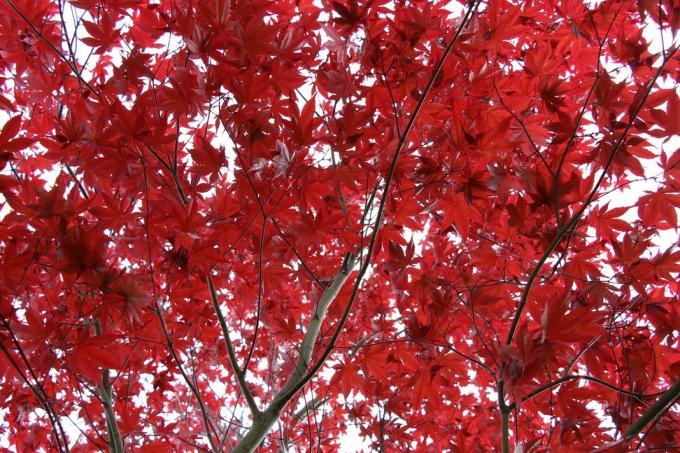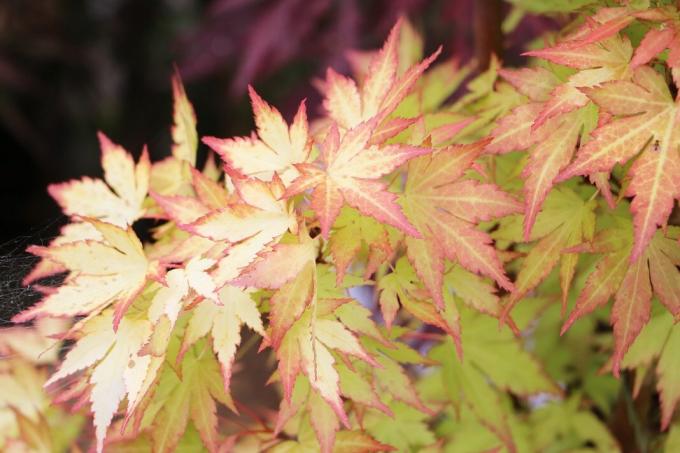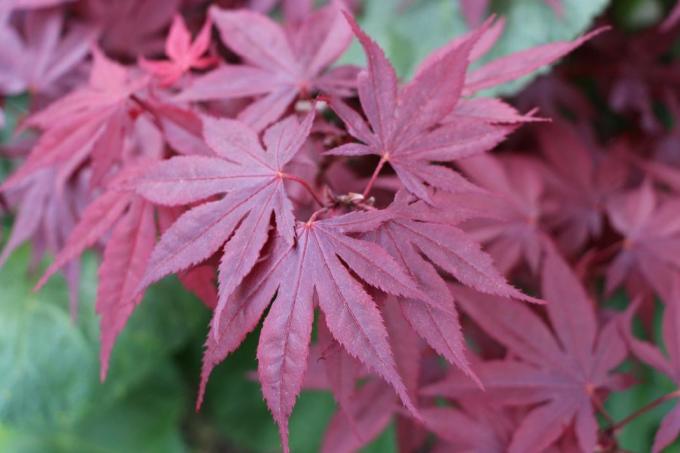
table of contents
- growth
- care
- Location
- to water
- Fertilize
- Cut
- Overwinter
- Multiply
- Diseases
- sorts
Profile and care information open +conclude -
- Flower color
- Orange red
- Location
- Partial shade, sunny
- Heyday
- May June
- Growth habit
- bushy
- height
- up to 4 m
- Soil type
- stony
- Soil moisture
- moderately moist
- PH value
- neutral, slightly acidic
- Limescale tolerance
- Calcium intolerant
- humus
- rich in humus
- Poisonous
- no
- Plant families
- Soap Tree Family, Sapindaceae
- Plant species
- Ornamental trees
- Garden style
- Japanese garden
In traditional Japanese Garden design Japanese maple is a fundamental element, especially its red-leaved varieties. Red Japanese maple is also extremely popular among German hobby gardeners. In addition to green varieties, as pond border planting, background or solitary plants, there are impressive color combinations. The splendid autumn colors of the filigree leaves, which show up in different shades of red, and the coral-red bark of some varieties make the unique ornamental value of this woody plant.
growth
Acer palmatum is a spectacular exotic and an attractive addition to small or large gardens. In nurseries it is also often offered as a split maple, which is also Acer palmatum. The growth of the red Japanese maple is mostly shrub-like, although it can also be grown as a tree.
Its heights vary between 100 and 500 cm. The decorative, up to 20 cm long leaves are lobed or slit to different depths. The inconspicuous flowers appear between May and June.
care
In principle, it does not require a lot of effort for the red Japanese maple to permanently retain its beauty and, above all, its spectacular autumn colors. Nevertheless, he is a bit picky about location and fertilization.

Location
In addition to the respective variety, the location has a decisive influence on the intensity of the leaf color. In contrast to sun-sensitive species such as Acer shirasawanum, Acer palmatum prefers sunny and very light partially shaded locations that are protected from wind and heavy rain. Here it can unfold its full splendor. However, blazing midday sun should be avoided.
A place near a body of water is recommended. B. at a pond, because the higher humidity is particularly good for this ornamental wood. In no case should you choose a location for the red Japanese maple and Japanese maples in general, which was infested by the dreaded Verticillium wilt.
Soil condition
In its natural habitat, the Japanese maple grows on stony ground in mountainous regions. Accordingly, loose, water-permeable and humus-rich soils should also be preferred in the home garden. They can be slightly acidic to neutral, whereby the pH value should ideally be between 4.5 and 7.
Irrigation water and rainwater must be able to drain off well and waterlogging must be avoided. As a result, compacted soils are completely unsuitable. In waterlogged resp. compacted soils, oxygen deficiency quickly occurs, which leads to the death of the fine fiber roots, which are essential for the survival of this ornamental wood.
A high-quality substrate is ideal for keeping in a bucket Potted plants that is enriched with compost soil. Here, too, a permeable substrate and adequate drainage are essential for survival. So that the substrate remains permanently loose and permeable, you can mix in clay granules, expanded clay or the somewhat more expensive Geohumus.
Planting in the garden
The best time to plant is in late spring, when the soil is already a little warmer. In this way, the Japanese maple can develop enough roots by the onset of winter and gain a foothold in the new location. In contrast, container goods can be planted during the entire growing season.
- When choosing a location, ensure that there is sufficient distance from other trees
- some varieties can reach a considerable three or four meters in width when old
- Only transplant specimens older than four years in an extreme emergency
- red Japanese maple is one of the shallow roots, its roots grow very expansively
- consequently, the root area must be dug out very generously
- you dig a sufficiently large planting hole
- A large portion of ripe compost is mixed in with the excavated earth
- the soil can also be improved with expanded clay or coarse sand
- this is particularly useful for heavier, less permeable soils
- the soil in the planting area to a depth of approx. Thoroughly loosen up 50 cm
- insert the plant in the middle and fill it with excavated earth
- Finally, lightly tread the soil in the root area and water
Tub planting
In principle, almost all varieties of Acer palmatum can be cultivated in a tub, provided that it is large enough. Dwarf varieties are particularly suitable. The tub should be about a sixth to a quarter of the final tree height in diameter.
In addition, it is advisable not to use plastic containers and to use clay pots instead. Plastic pots heat up very quickly in the sun. Clay, on the other hand, provides a certain amount of cooling due to better evaporation. However, the substrate dries out faster here, so it has to be poured more often.
The depth of the respective bucket should be at least one and a half times the size of the root ball. First, a layer of clay granulate, expanded clay or coarse gravel, several centimeters thick, is placed in the bucket. On top of that comes some substrate. Now the plant is placed in the middle and filled with substrate up to about 5 cm below the edge. Finally, press the soil down and water well.
to water
Even if the Japanese maple does not like waterlogging, young and freshly planted specimens in particular need a relatively large amount of water. One of the reasons for this is that this Woods Are shallow roots and therefore do not get moisture from deeper layers of the earth. As a result, they cannot supply themselves adequately with the precious water, especially in summer. Therefore, you should water abundantly regularly and in warm, dry weather. Older specimens are only additionally watered in persistent drought, they usually survive a temporary lack of water without any problems.

There is only a limited space available for potted plants, the substrate dries out much faster than in the garden. That makes both watering and the supply of nutrients a little more difficult. It is poured regularly. The larger the Japanese maple, the higher the water requirement.
Fertilize
As far as the supply of nutrients is concerned, this plant is relatively frugal. When fertilizing this ornamental wood, caution is required, as the roots run relatively close to the surface of the earth.
- Mix in compost when planting
- then no further fertilization is required in the first year
- Spread compost again in the second year
- the first time in April and again in June
- or use a liquid maple fertilizer
- Apply liquid fertilizer over the irrigation water every 3-4 weeks from April to August
- excessive fertilization should be avoided
- it reduces the winter hardiness and affects the autumn color of the leaves
Even when fertilizing potted plants, less is more. A good complete fertilizer or some compost once a month from April to August are completely sufficient.
Cut
Japanese maple generally does not tolerate pruning as well. Small corrections such as the removal of damaged, dried up or dead shoots are usually not a problem, although here, too, caution is called for. Larger cutting measures, on the other hand, should only be carried out in exceptional cases. Before making a cut, you should consider that cuts in the Japanese maple remain visible for a very long time and branches that are removed directly from the trunk are very difficult or even impossible to replace.
If pruning cannot be avoided, it should be done in late summer if possible, then the flow of sap is lowest and the cuts can heal by autumn / winter. In principle, you should not use old wood, but only fresh or This year's wood should be cut, because this is the only place where new shoots develop.
It is always best to cut above a branch or about 2 cm above a bud. The plant always dries back a little at the interfaces, which can also affect dormant buds. Therefore one should not cut too tightly. In spite of everything, the Japanese maple is at its most beautiful when it is not cut and its characteristic growth shape is retained.
Overwinter
Red Japanese maple has good winter hardiness in the right location. Only with very young or freshly planted specimens is it advisable to cover the root area with a layer of straw and fir branches. The crown can also be wrapped with a fleece.

Wintering is a bit more complex for potted plants. Either you overwinter them indoors or put them outdoors in a sheltered place, ideally in front of a wall or house wall. To protect the root area, the bucket should be placed on a warming styrofoam plate and wrapped with bubble wrap, straw mats and / or fleece.
In addition, you can cover the root area with dry leaves or straw. The above-ground parts of the plant are also covered with a fleece. Plants in the tub must also be supplied with water in winter, but only on frost-free days, less frequently and only in moderation.
Multiply
sowing
Growing from seeds is possible all year round. However, no single-variety plants emerge from it. In addition, several seeds should always be used, because only about one in six will sprout. Since the seeds are cold germs, they must first be subjected to a cold treatment. To do this, put them in the refrigerator for about 14 days at 3-8 degrees and then soak them in hot water for 24 hours.
Then they are approx. Sown 1 cm deep in potting soil, moisten the substrate and keep it evenly moist until germination. The germination period is 6-10 weeks in a light and moderately warm place. As soon as the young seedlings have several leaves, they can be separated. In the first year it is advisable to overwinter them indoors and only plant them in the garden the next spring.
Cuttings
Propagation via cuttings does not work with every red Japanese maple, which is why nurseries grow young plants mainly through grafting. If you still want to try your hand at cuttings, you should consider a few things.
- Fill the planter with potting soil
- Moisten the substrate well with a spray bottle
- work some root activator into the substrate
- Cut 10 - 15 cm long, half lignified cuttings from the mother plant
- they should have at least 3 pairs of leaves
- remove the lowest leaves and the tip of the shoot
- cut the lower end of the cuttings at an angle
- Cut remaining leaves in half or third to minimize evaporation
- Put in the prepared potting soil and press the soil down
- cover with cling film to ensure sufficient humidity
- Place the seed container in a bright and warm place without direct sunlight
- Remove the film from time to time to avoid mold formation
- it can take several weeks for the roots to develop
- If possible, disinfect cutting tools before and after cutting
Diseases
Verticillium wilt
Red Japanese maple is quite straightforward under optimal conditions. Nevertheless, it is susceptible to the dreaded Verticillium wilt caused by fungi. These fungi live in the soil and penetrate the ducts in the wood via the roots, where they spread and block them. As a result, the maple is no longer adequately supplied with water and nutrients and eventually dies. The first signs are sagging, withered leaves and dying branches.

Fighting is hardly possible. Neither fungicides nor vigorous pruning can save the wood. As a rule, all that remains is to remove and dispose of the entire plant. The only thing you can do is prevent it. For this you should pay attention to the best possible site conditions and soil quality. Japanese maple should never be planted in locations contaminated with Verticillium. Even a large-scale replacement of the soil would not be sufficient here.
sorts
Acer palmatum 'Atropurpureum'
The deeply slit leaves of this red-leaved Japanese maple are purple with a light bronze tone in summer. In autumn they are bright red. It grows as a large shrub or small tree and can reach heights of 300 - 400 m.
Acer palmatum 'Bloodgood'
The initially black-red foliage of this resistant variety turns a bright red color in autumn. Its leaves are deeply slit and it reaches heights of growth between 400 and 500 m.
Acer palmatum 'Fireglow'
The slightly serrated, extremely decorative leaves of Acer palmatum 'Fireglow' are bright velvet red and turn orange-red in autumn. It grows wide and compact with heights of 200-350 cm.
Acer palmatum 'Oregon Sunset'
This dwarf form with bushy growth becomes about 150 cm high. Its leaves, which are also deeply slit, are initially bright red and turn red-purple in autumn.
Acer palmatum 'Moonfire'
The buds of the 'Moonfire' variety are light purple-red. In summer the foliage takes on a dark purple-red color, which turns into a bright deep red in autumn. Their maximum height is 300cm.



